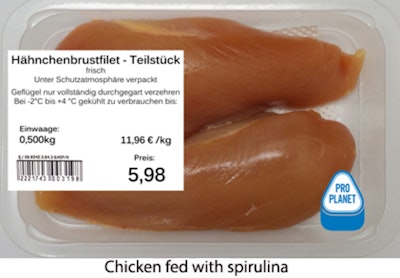
As the poultry industry continues to explore the use of alternative feedstuffs like insects and algae, consumer acceptance will require full transparency.
“If you’re going to use alternative feedstuffs, make sure to market it that way,” said Dr. Brianne Altmann, lead researcher, University of Göttingen.
The alternative feedstuff market will be niche in a similar way to organic chicken or grass-fed beef, but it could be the next big thing for the chicken market, she added.
“The industry should stay true to themselves and when they innovate, they should definitely let the consumer know,” Altman said. “Transparency is the way to go and the only way to gain more acceptance.”
Altman, alongside other researchers from University of Göttingen and the University of Alberta, Edmonton, Canada, examined the effects of information about the use of algae and insects in the food chain.
Alternative feedstuffs in broiler diets
The use of insect proteins and algae to replace soybean meal has become popular as an alternative feedstuff for broilers in recent years.
In the wild, poultry will naturally eat insects, considered to be a protein-rich food source high in energy such as lauric acid, a C-12 saturated fatty acid with demonstrated value-added, antimicrobial and antibacterial properties.
Spirulina, a form of algae, is another alternative feedstuff used in broiler diets. However, the diet often results in a product with a dark orange color and intense chicken flavor.
Consumer perceptions on spirulina vs. insect meal
The researchers surveyed 1,000 consumers on their perceptions of photographed chicken breasts fed either spirulina or insect meal designed to imitate market-ready products. The product labels also included health and sustainability claims and price.
One group of respondents received the information on the packaging only, while the other was given additional information on the alternative feedstuffs. This information proved crucial, given that spirulina affects the color of the end product.
Consumer education influences preference
The results, published in the journal Food Policy, revealed that respondents preferred the chicken breast reared with insect meal. This reaction was likely due to a rejection of the intense color produced by the spirulina.
However, that preference changed once the foodstuff was identified. Once that occurred, only the sustainability-minded consumers still chose the insects as a feedstuff, suggesting that most consumers still feel an aversion to the consumption of insect proteins.
“The main takeaway is that consumers are very different. They’re very heterogenous and there’s always going to be a diversity of preferences,” Altman said. “There are a lot of diverse marketing avenues available.”


















